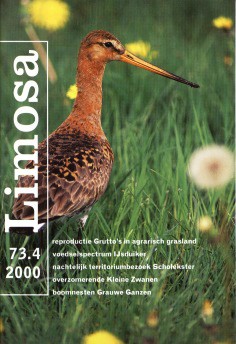| JUKEMA J & HULSCHER JB (2000) Do Oystercatcher Haematopus ostralegus visit their breeding territory only during moonlit nights in early spring?. LIMOSA 73 (4): 144-146.
The first author made observations on the presence and absence of a pair of Oystercatchers breeding near his farm at Oosterbierum in the north of the Netherlands (Iocalised by sound). In the very beginning of the season the birds appeared to be present around eleven '0 clock in the nights around full moon. They were absent in the nights around new moon and during the daytime. The birds' first visit to the territory during daytime occurred at least three weeks (in 1999) and two weeks (in 2000) alter the first nocturnal visit. After that first visit in daytime the birds were continuously present on the following days. The nocturnal visits coincided with periods of high tide at the feeding area in the birds were continuously present on the following days. The nocturnal visits coincided with periods of high tide at the feeding area in the Wadden Sea at two km distance Being present on the inland territory at that moment causes no loss of intertidal feeding time. The nightly presence and accompanying vocal ctivity during moonlit nights might be related to claiming of territorial rights for the forthcoming breeding season. It is not clear why early in the season the birds only visited the territory at high tide durng moonlit nights and not at high tide during daytime.Eurasian Oystercatcher Haematopus ostralegus
[free pdf] [dutch summary]
|
|

[full content of this issue]
|





